NHA Wi-Fi Reach Project: Risk and Procurement Management Assessment
VerifiedAdded on 2020/05/28
|13
|3399
|119
Report
AI Summary
This report analyzes the Wi-Fi reach project undertaken by Medical Innovations Limited (MIL) for the National Health Authority (NHA). The project aimed to improve healthcare communication through Wi-Fi implementation. The report identifies delays due to inadequate project management, including issues with inflexible contract terms, insufficient training, and poor risk management. It examines problems in procurement, the contract between NHA and MIL, and recommends an action plan to improve project management, including iterative planning, proper budgeting, and adherence to defined project standards. The report concludes by offering recommendations to address the identified issues and improve the project's outcome. Key issues include delays in the pre-qualification phase, customization challenges, and poor risk assessment, leading to time and cost overruns. The report suggests improvements in contract terms and a more flexible approach to training services.
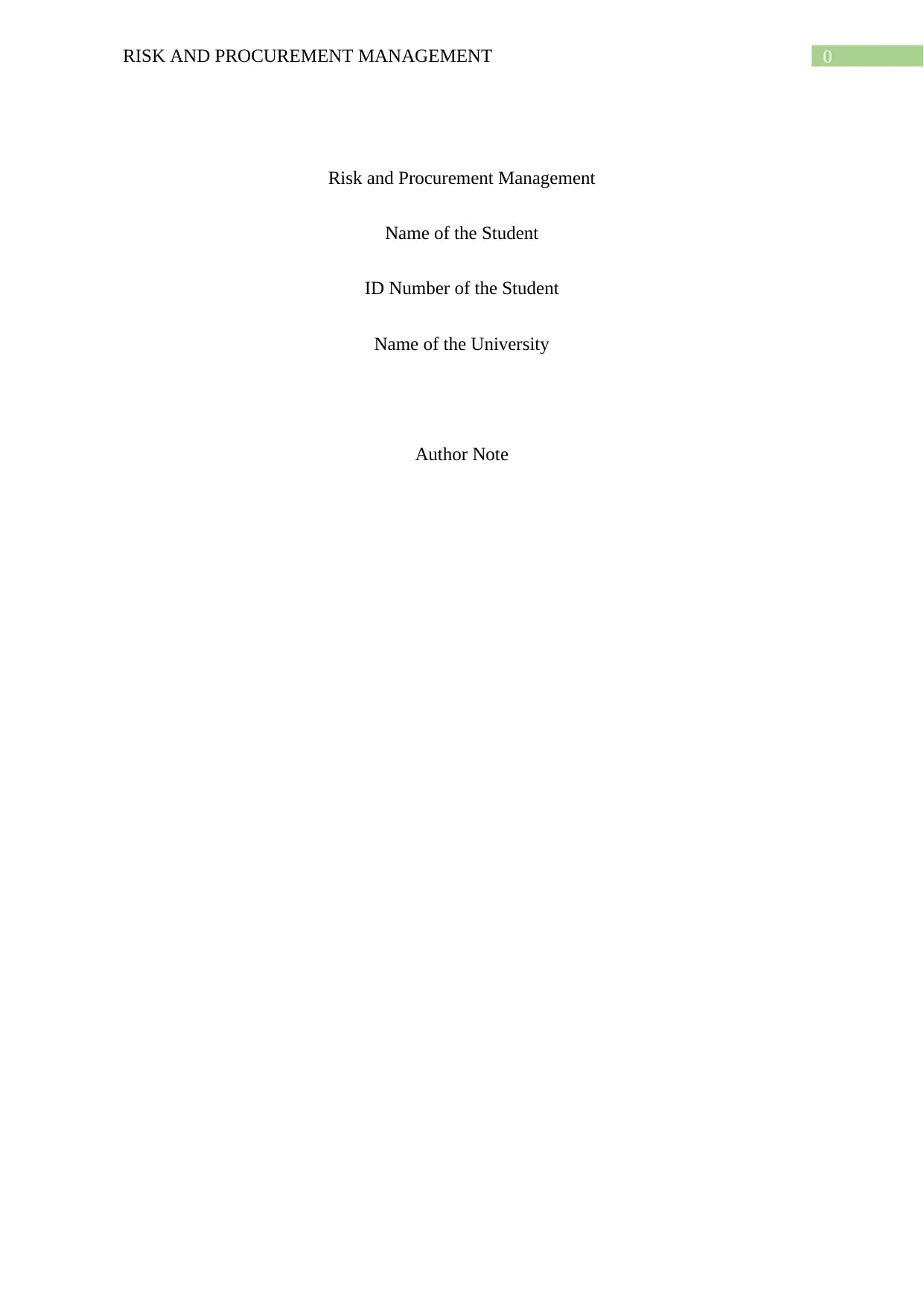
0RISK AND PROCUREMENT MANAGEMENT
Risk and Procurement Management
Name of the Student
ID Number of the Student
Name of the University
Author Note
Risk and Procurement Management
Name of the Student
ID Number of the Student
Name of the University
Author Note
Paraphrase This Document
Need a fresh take? Get an instant paraphrase of this document with our AI Paraphraser
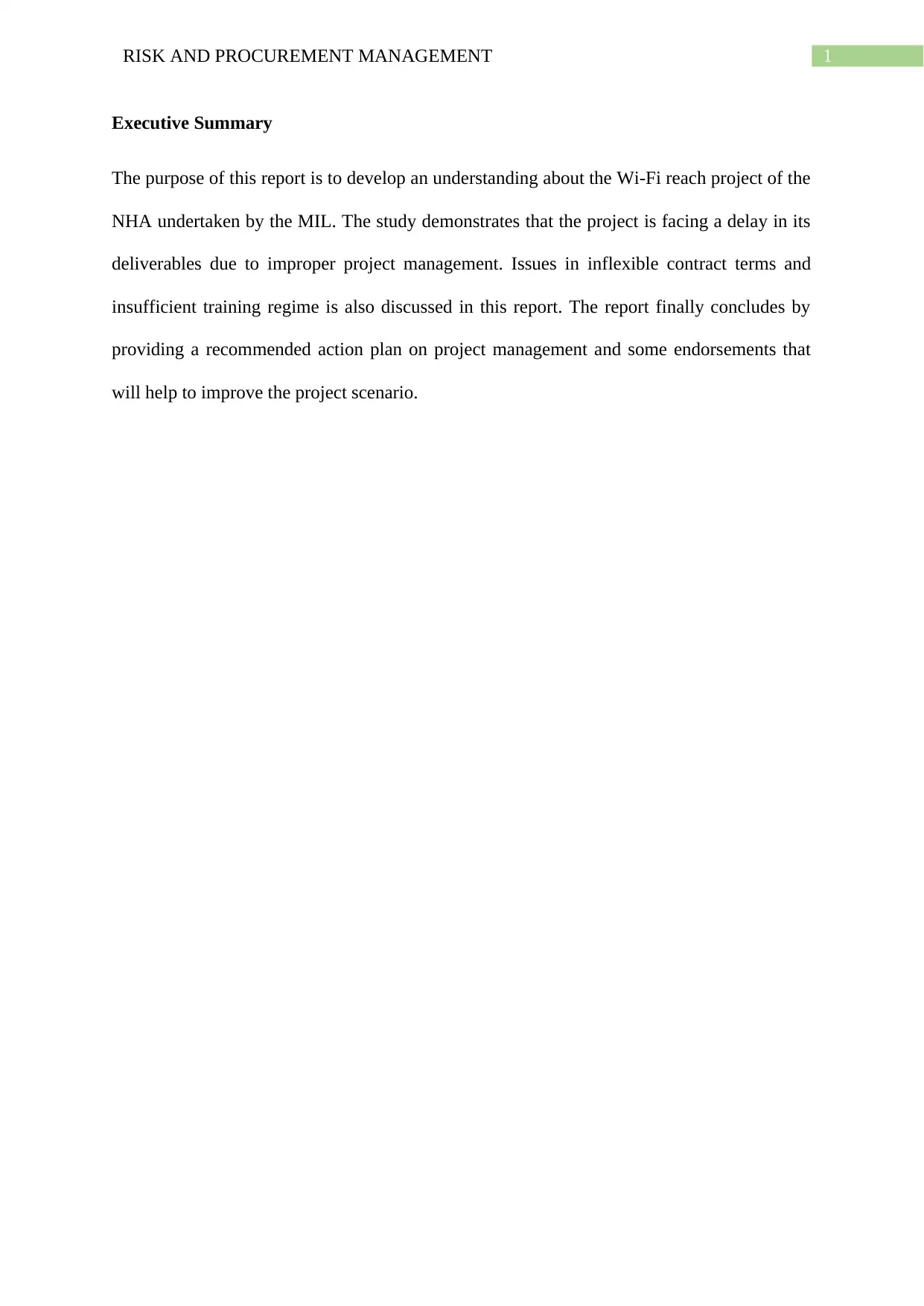
1RISK AND PROCUREMENT MANAGEMENT
Executive Summary
The purpose of this report is to develop an understanding about the Wi-Fi reach project of the
NHA undertaken by the MIL. The study demonstrates that the project is facing a delay in its
deliverables due to improper project management. Issues in inflexible contract terms and
insufficient training regime is also discussed in this report. The report finally concludes by
providing a recommended action plan on project management and some endorsements that
will help to improve the project scenario.
Executive Summary
The purpose of this report is to develop an understanding about the Wi-Fi reach project of the
NHA undertaken by the MIL. The study demonstrates that the project is facing a delay in its
deliverables due to improper project management. Issues in inflexible contract terms and
insufficient training regime is also discussed in this report. The report finally concludes by
providing a recommended action plan on project management and some endorsements that
will help to improve the project scenario.
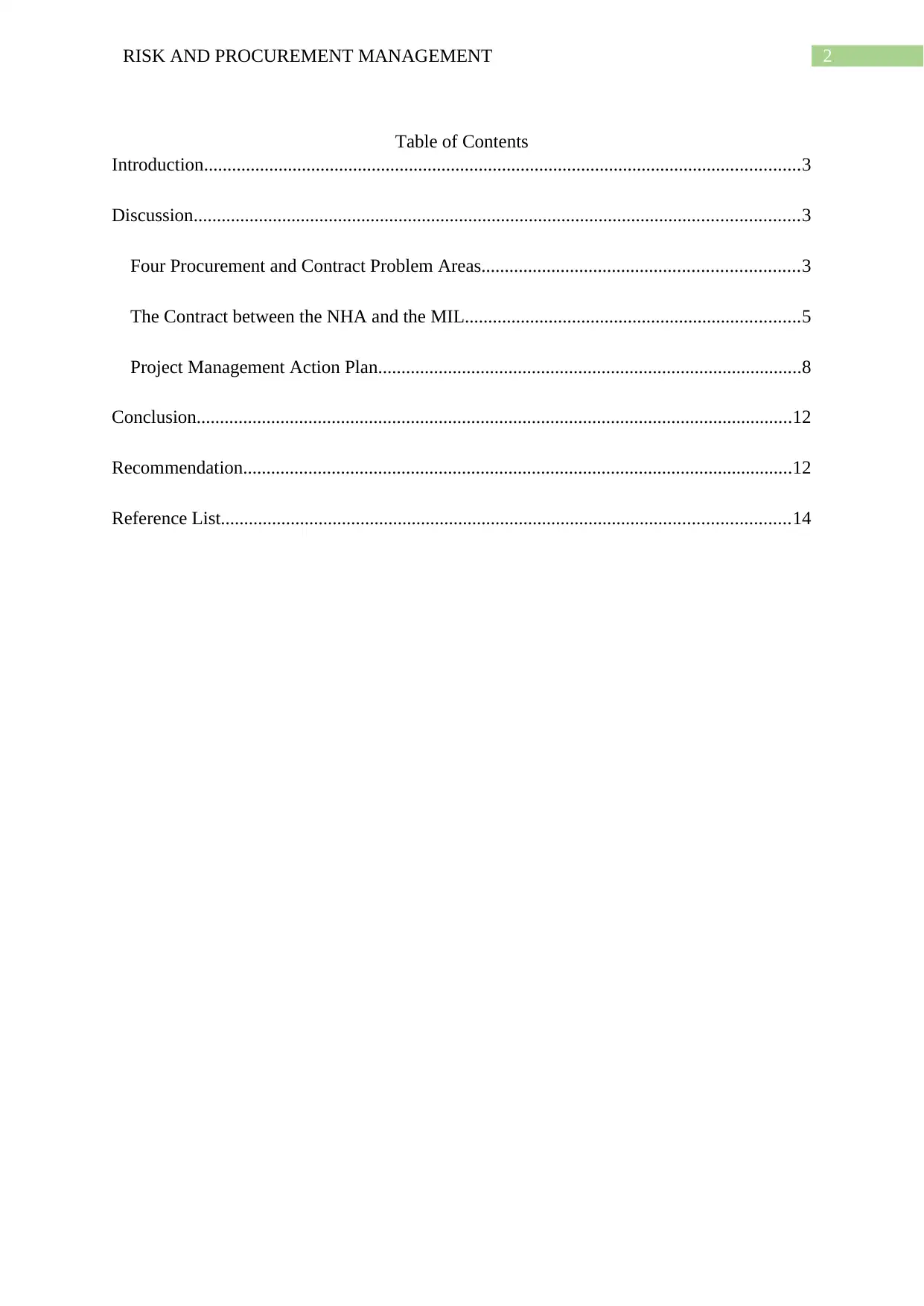
2RISK AND PROCUREMENT MANAGEMENT
Table of Contents
Introduction................................................................................................................................3
Discussion..................................................................................................................................3
Four Procurement and Contract Problem Areas....................................................................3
The Contract between the NHA and the MIL........................................................................5
Project Management Action Plan...........................................................................................8
Conclusion................................................................................................................................12
Recommendation......................................................................................................................12
Reference List..........................................................................................................................14
Table of Contents
Introduction................................................................................................................................3
Discussion..................................................................................................................................3
Four Procurement and Contract Problem Areas....................................................................3
The Contract between the NHA and the MIL........................................................................5
Project Management Action Plan...........................................................................................8
Conclusion................................................................................................................................12
Recommendation......................................................................................................................12
Reference List..........................................................................................................................14
⊘ This is a preview!⊘
Do you want full access?
Subscribe today to unlock all pages.

Trusted by 1+ million students worldwide
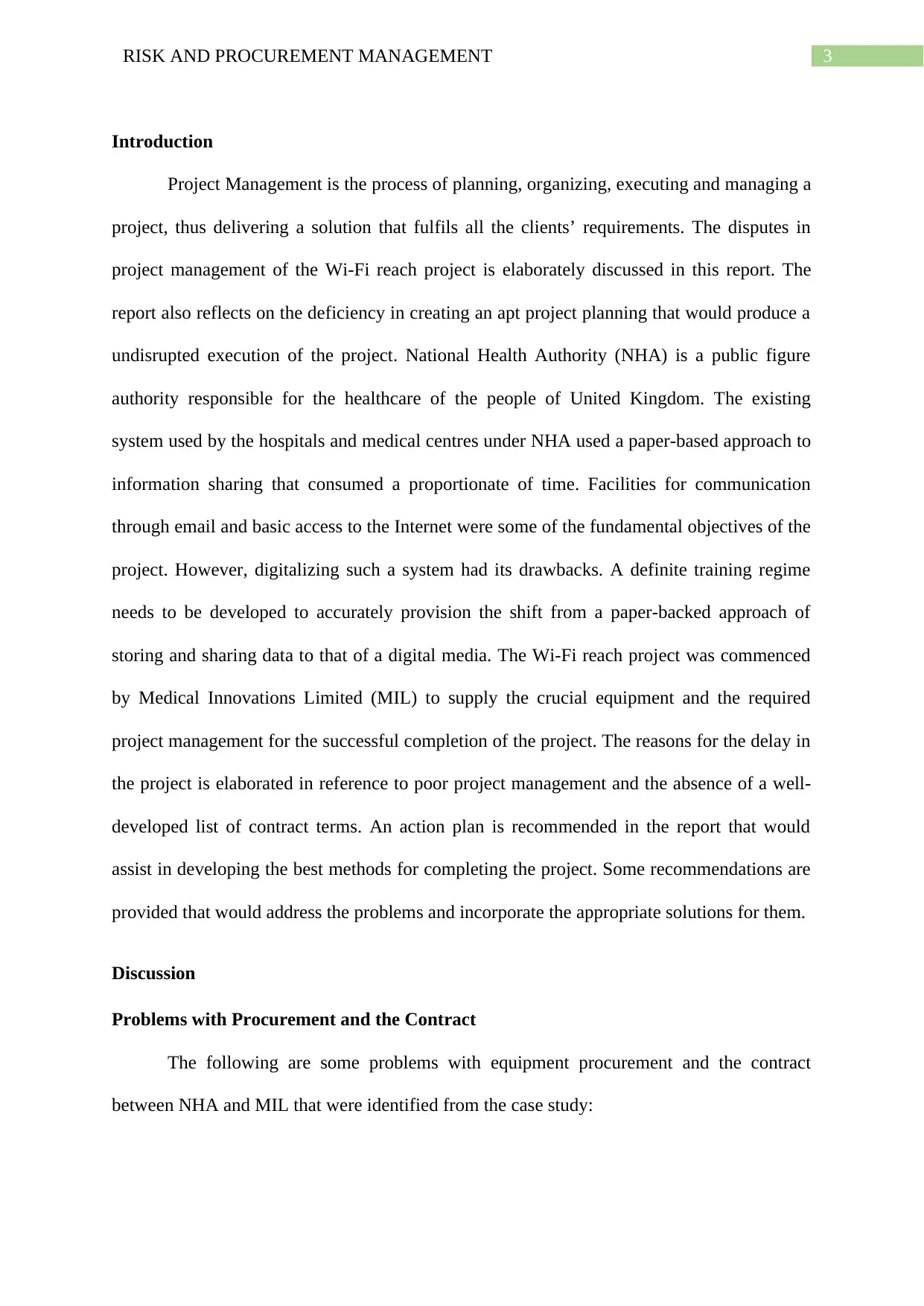
3RISK AND PROCUREMENT MANAGEMENT
Introduction
Project Management is the process of planning, organizing, executing and managing a
project, thus delivering a solution that fulfils all the clients’ requirements. The disputes in
project management of the Wi-Fi reach project is elaborately discussed in this report. The
report also reflects on the deficiency in creating an apt project planning that would produce a
undisrupted execution of the project. National Health Authority (NHA) is a public figure
authority responsible for the healthcare of the people of United Kingdom. The existing
system used by the hospitals and medical centres under NHA used a paper-based approach to
information sharing that consumed a proportionate of time. Facilities for communication
through email and basic access to the Internet were some of the fundamental objectives of the
project. However, digitalizing such a system had its drawbacks. A definite training regime
needs to be developed to accurately provision the shift from a paper-backed approach of
storing and sharing data to that of a digital media. The Wi-Fi reach project was commenced
by Medical Innovations Limited (MIL) to supply the crucial equipment and the required
project management for the successful completion of the project. The reasons for the delay in
the project is elaborated in reference to poor project management and the absence of a well-
developed list of contract terms. An action plan is recommended in the report that would
assist in developing the best methods for completing the project. Some recommendations are
provided that would address the problems and incorporate the appropriate solutions for them.
Discussion
Problems with Procurement and the Contract
The following are some problems with equipment procurement and the contract
between NHA and MIL that were identified from the case study:
Introduction
Project Management is the process of planning, organizing, executing and managing a
project, thus delivering a solution that fulfils all the clients’ requirements. The disputes in
project management of the Wi-Fi reach project is elaborately discussed in this report. The
report also reflects on the deficiency in creating an apt project planning that would produce a
undisrupted execution of the project. National Health Authority (NHA) is a public figure
authority responsible for the healthcare of the people of United Kingdom. The existing
system used by the hospitals and medical centres under NHA used a paper-based approach to
information sharing that consumed a proportionate of time. Facilities for communication
through email and basic access to the Internet were some of the fundamental objectives of the
project. However, digitalizing such a system had its drawbacks. A definite training regime
needs to be developed to accurately provision the shift from a paper-backed approach of
storing and sharing data to that of a digital media. The Wi-Fi reach project was commenced
by Medical Innovations Limited (MIL) to supply the crucial equipment and the required
project management for the successful completion of the project. The reasons for the delay in
the project is elaborated in reference to poor project management and the absence of a well-
developed list of contract terms. An action plan is recommended in the report that would
assist in developing the best methods for completing the project. Some recommendations are
provided that would address the problems and incorporate the appropriate solutions for them.
Discussion
Problems with Procurement and the Contract
The following are some problems with equipment procurement and the contract
between NHA and MIL that were identified from the case study:
Paraphrase This Document
Need a fresh take? Get an instant paraphrase of this document with our AI Paraphraser
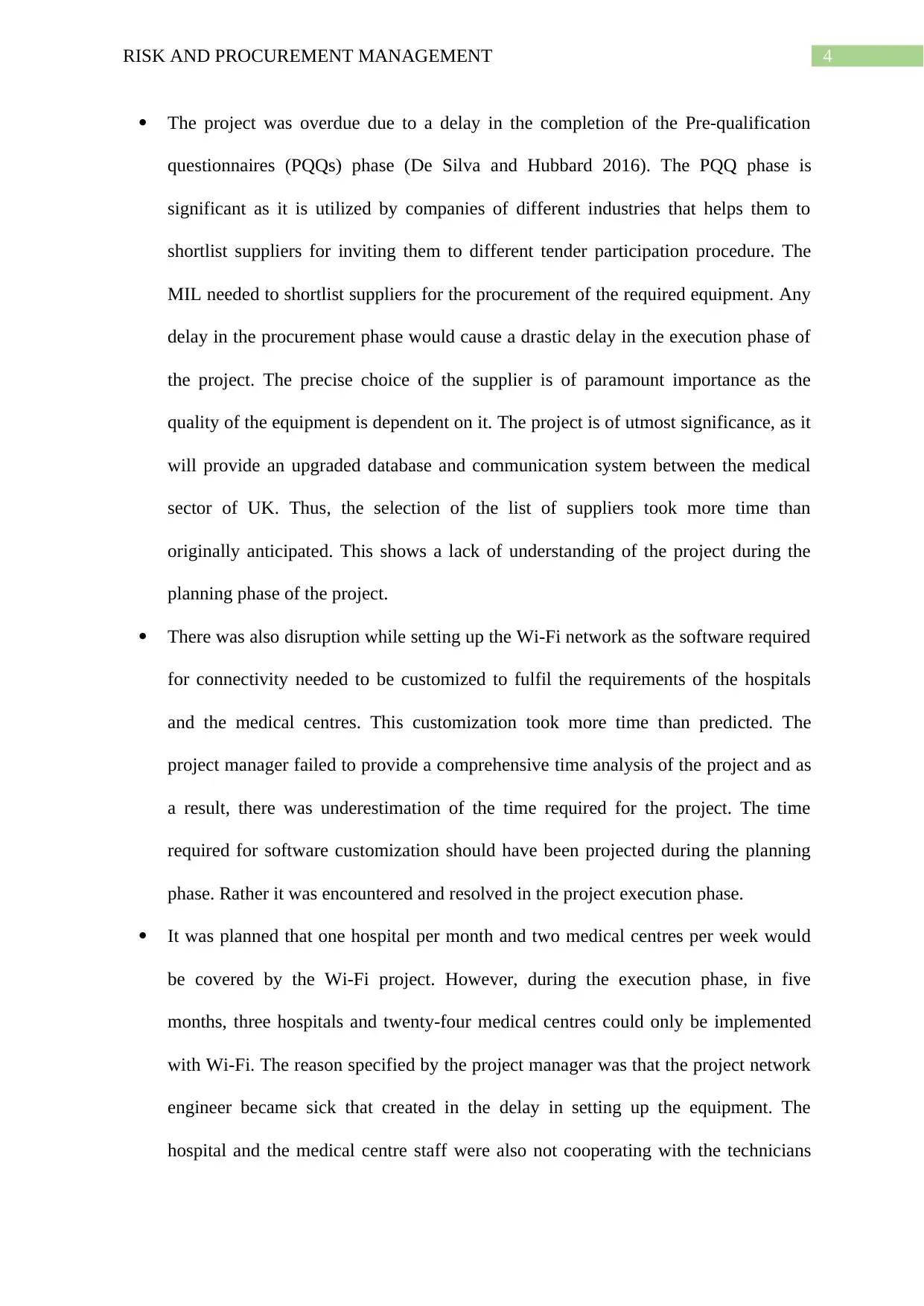
4RISK AND PROCUREMENT MANAGEMENT
The project was overdue due to a delay in the completion of the Pre-qualification
questionnaires (PQQs) phase (De Silva and Hubbard 2016). The PQQ phase is
significant as it is utilized by companies of different industries that helps them to
shortlist suppliers for inviting them to different tender participation procedure. The
MIL needed to shortlist suppliers for the procurement of the required equipment. Any
delay in the procurement phase would cause a drastic delay in the execution phase of
the project. The precise choice of the supplier is of paramount importance as the
quality of the equipment is dependent on it. The project is of utmost significance, as it
will provide an upgraded database and communication system between the medical
sector of UK. Thus, the selection of the list of suppliers took more time than
originally anticipated. This shows a lack of understanding of the project during the
planning phase of the project.
There was also disruption while setting up the Wi-Fi network as the software required
for connectivity needed to be customized to fulfil the requirements of the hospitals
and the medical centres. This customization took more time than predicted. The
project manager failed to provide a comprehensive time analysis of the project and as
a result, there was underestimation of the time required for the project. The time
required for software customization should have been projected during the planning
phase. Rather it was encountered and resolved in the project execution phase.
It was planned that one hospital per month and two medical centres per week would
be covered by the Wi-Fi project. However, during the execution phase, in five
months, three hospitals and twenty-four medical centres could only be implemented
with Wi-Fi. The reason specified by the project manager was that the project network
engineer became sick that created in the delay in setting up the equipment. The
hospital and the medical centre staff were also not cooperating with the technicians
The project was overdue due to a delay in the completion of the Pre-qualification
questionnaires (PQQs) phase (De Silva and Hubbard 2016). The PQQ phase is
significant as it is utilized by companies of different industries that helps them to
shortlist suppliers for inviting them to different tender participation procedure. The
MIL needed to shortlist suppliers for the procurement of the required equipment. Any
delay in the procurement phase would cause a drastic delay in the execution phase of
the project. The precise choice of the supplier is of paramount importance as the
quality of the equipment is dependent on it. The project is of utmost significance, as it
will provide an upgraded database and communication system between the medical
sector of UK. Thus, the selection of the list of suppliers took more time than
originally anticipated. This shows a lack of understanding of the project during the
planning phase of the project.
There was also disruption while setting up the Wi-Fi network as the software required
for connectivity needed to be customized to fulfil the requirements of the hospitals
and the medical centres. This customization took more time than predicted. The
project manager failed to provide a comprehensive time analysis of the project and as
a result, there was underestimation of the time required for the project. The time
required for software customization should have been projected during the planning
phase. Rather it was encountered and resolved in the project execution phase.
It was planned that one hospital per month and two medical centres per week would
be covered by the Wi-Fi project. However, during the execution phase, in five
months, three hospitals and twenty-four medical centres could only be implemented
with Wi-Fi. The reason specified by the project manager was that the project network
engineer became sick that created in the delay in setting up the equipment. The
hospital and the medical centre staff were also not cooperating with the technicians
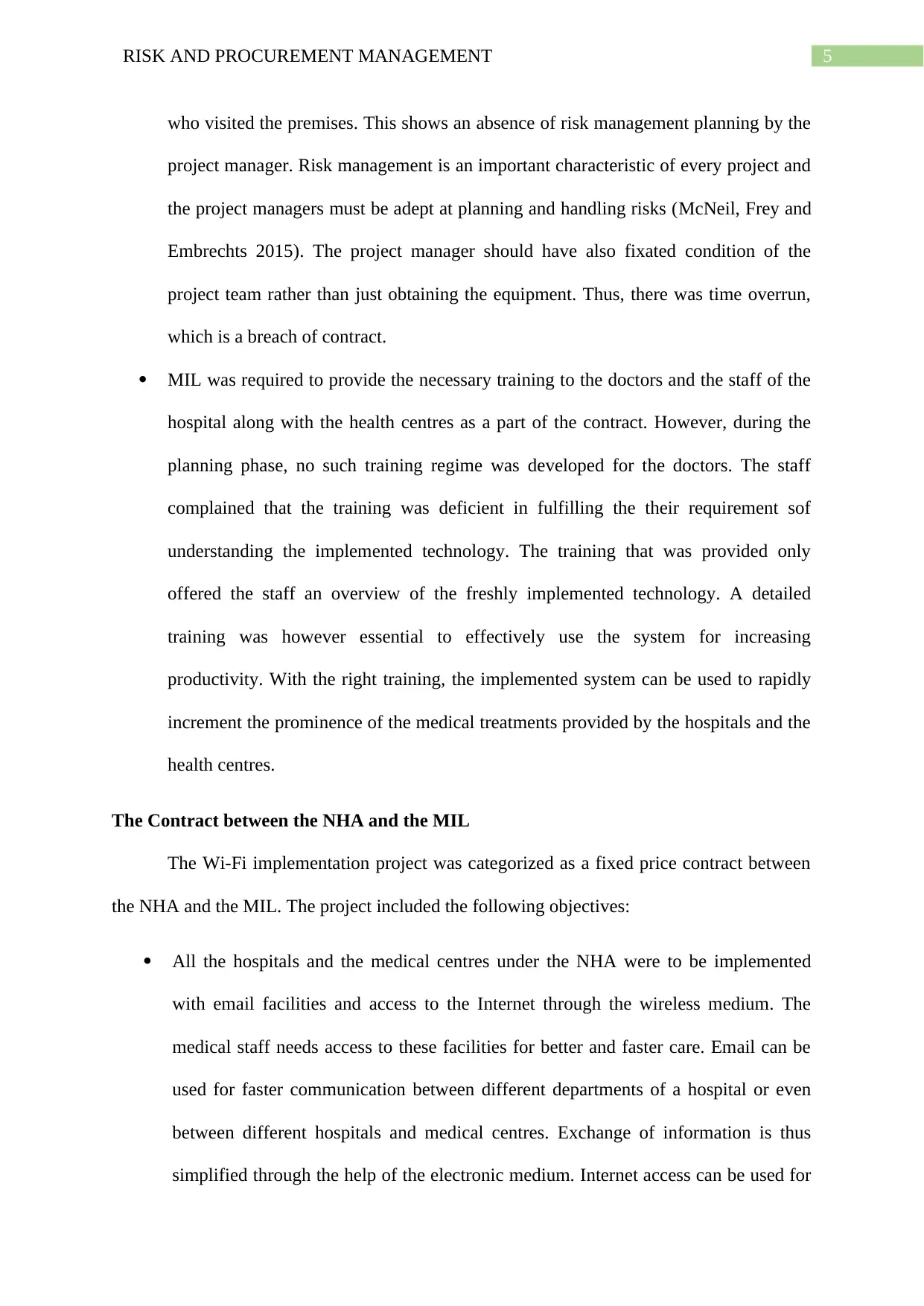
5RISK AND PROCUREMENT MANAGEMENT
who visited the premises. This shows an absence of risk management planning by the
project manager. Risk management is an important characteristic of every project and
the project managers must be adept at planning and handling risks (McNeil, Frey and
Embrechts 2015). The project manager should have also fixated condition of the
project team rather than just obtaining the equipment. Thus, there was time overrun,
which is a breach of contract.
MIL was required to provide the necessary training to the doctors and the staff of the
hospital along with the health centres as a part of the contract. However, during the
planning phase, no such training regime was developed for the doctors. The staff
complained that the training was deficient in fulfilling the their requirement sof
understanding the implemented technology. The training that was provided only
offered the staff an overview of the freshly implemented technology. A detailed
training was however essential to effectively use the system for increasing
productivity. With the right training, the implemented system can be used to rapidly
increment the prominence of the medical treatments provided by the hospitals and the
health centres.
The Contract between the NHA and the MIL
The Wi-Fi implementation project was categorized as a fixed price contract between
the NHA and the MIL. The project included the following objectives:
All the hospitals and the medical centres under the NHA were to be implemented
with email facilities and access to the Internet through the wireless medium. The
medical staff needs access to these facilities for better and faster care. Email can be
used for faster communication between different departments of a hospital or even
between different hospitals and medical centres. Exchange of information is thus
simplified through the help of the electronic medium. Internet access can be used for
who visited the premises. This shows an absence of risk management planning by the
project manager. Risk management is an important characteristic of every project and
the project managers must be adept at planning and handling risks (McNeil, Frey and
Embrechts 2015). The project manager should have also fixated condition of the
project team rather than just obtaining the equipment. Thus, there was time overrun,
which is a breach of contract.
MIL was required to provide the necessary training to the doctors and the staff of the
hospital along with the health centres as a part of the contract. However, during the
planning phase, no such training regime was developed for the doctors. The staff
complained that the training was deficient in fulfilling the their requirement sof
understanding the implemented technology. The training that was provided only
offered the staff an overview of the freshly implemented technology. A detailed
training was however essential to effectively use the system for increasing
productivity. With the right training, the implemented system can be used to rapidly
increment the prominence of the medical treatments provided by the hospitals and the
health centres.
The Contract between the NHA and the MIL
The Wi-Fi implementation project was categorized as a fixed price contract between
the NHA and the MIL. The project included the following objectives:
All the hospitals and the medical centres under the NHA were to be implemented
with email facilities and access to the Internet through the wireless medium. The
medical staff needs access to these facilities for better and faster care. Email can be
used for faster communication between different departments of a hospital or even
between different hospitals and medical centres. Exchange of information is thus
simplified through the help of the electronic medium. Internet access can be used for
⊘ This is a preview!⊘
Do you want full access?
Subscribe today to unlock all pages.

Trusted by 1+ million students worldwide
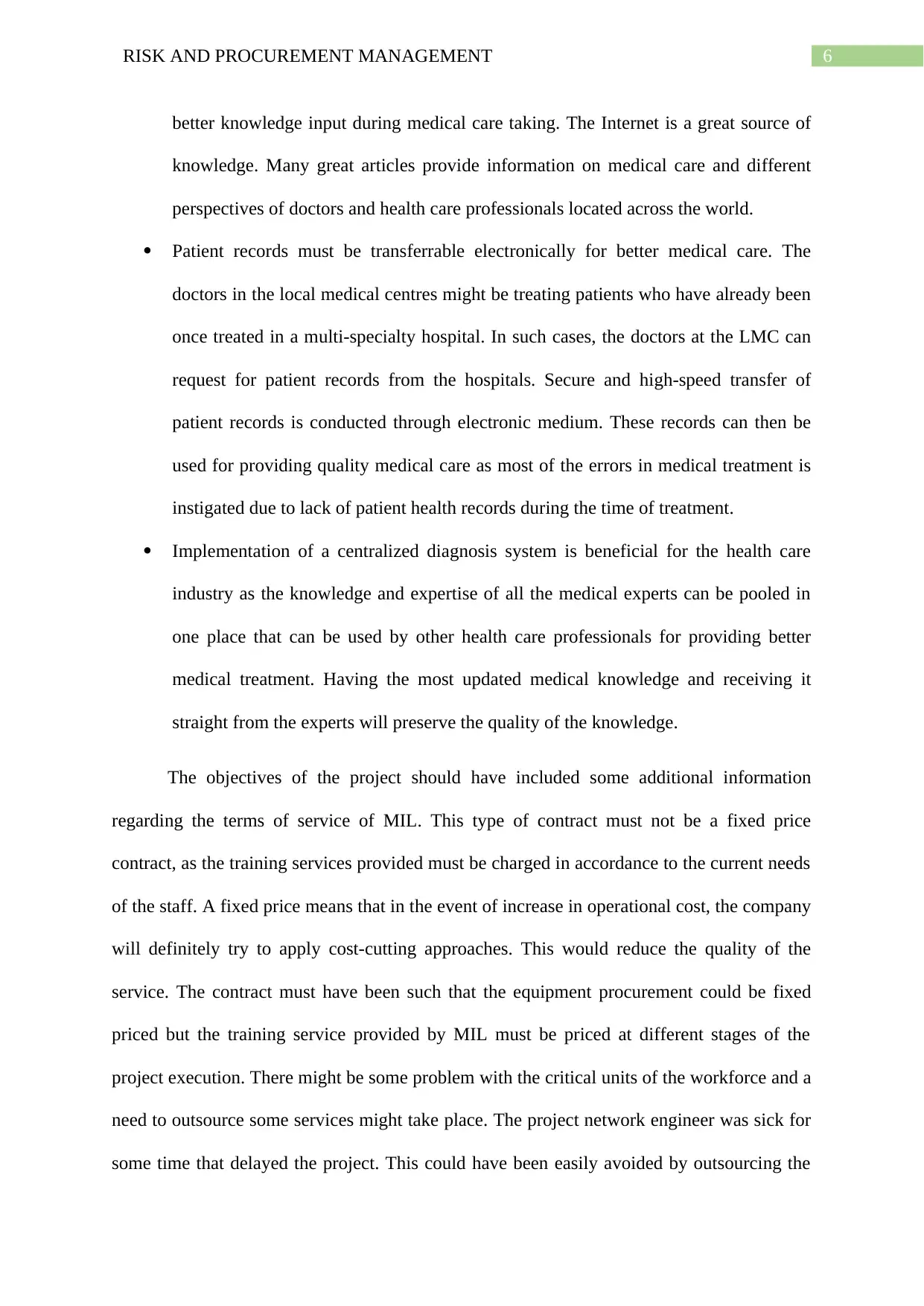
6RISK AND PROCUREMENT MANAGEMENT
better knowledge input during medical care taking. The Internet is a great source of
knowledge. Many great articles provide information on medical care and different
perspectives of doctors and health care professionals located across the world.
Patient records must be transferrable electronically for better medical care. The
doctors in the local medical centres might be treating patients who have already been
once treated in a multi-specialty hospital. In such cases, the doctors at the LMC can
request for patient records from the hospitals. Secure and high-speed transfer of
patient records is conducted through electronic medium. These records can then be
used for providing quality medical care as most of the errors in medical treatment is
instigated due to lack of patient health records during the time of treatment.
Implementation of a centralized diagnosis system is beneficial for the health care
industry as the knowledge and expertise of all the medical experts can be pooled in
one place that can be used by other health care professionals for providing better
medical treatment. Having the most updated medical knowledge and receiving it
straight from the experts will preserve the quality of the knowledge.
The objectives of the project should have included some additional information
regarding the terms of service of MIL. This type of contract must not be a fixed price
contract, as the training services provided must be charged in accordance to the current needs
of the staff. A fixed price means that in the event of increase in operational cost, the company
will definitely try to apply cost-cutting approaches. This would reduce the quality of the
service. The contract must have been such that the equipment procurement could be fixed
priced but the training service provided by MIL must be priced at different stages of the
project execution. There might be some problem with the critical units of the workforce and a
need to outsource some services might take place. The project network engineer was sick for
some time that delayed the project. This could have been easily avoided by outsourcing the
better knowledge input during medical care taking. The Internet is a great source of
knowledge. Many great articles provide information on medical care and different
perspectives of doctors and health care professionals located across the world.
Patient records must be transferrable electronically for better medical care. The
doctors in the local medical centres might be treating patients who have already been
once treated in a multi-specialty hospital. In such cases, the doctors at the LMC can
request for patient records from the hospitals. Secure and high-speed transfer of
patient records is conducted through electronic medium. These records can then be
used for providing quality medical care as most of the errors in medical treatment is
instigated due to lack of patient health records during the time of treatment.
Implementation of a centralized diagnosis system is beneficial for the health care
industry as the knowledge and expertise of all the medical experts can be pooled in
one place that can be used by other health care professionals for providing better
medical treatment. Having the most updated medical knowledge and receiving it
straight from the experts will preserve the quality of the knowledge.
The objectives of the project should have included some additional information
regarding the terms of service of MIL. This type of contract must not be a fixed price
contract, as the training services provided must be charged in accordance to the current needs
of the staff. A fixed price means that in the event of increase in operational cost, the company
will definitely try to apply cost-cutting approaches. This would reduce the quality of the
service. The contract must have been such that the equipment procurement could be fixed
priced but the training service provided by MIL must be priced at different stages of the
project execution. There might be some problem with the critical units of the workforce and a
need to outsource some services might take place. The project network engineer was sick for
some time that delayed the project. This could have been easily avoided by outsourcing the
Paraphrase This Document
Need a fresh take? Get an instant paraphrase of this document with our AI Paraphraser
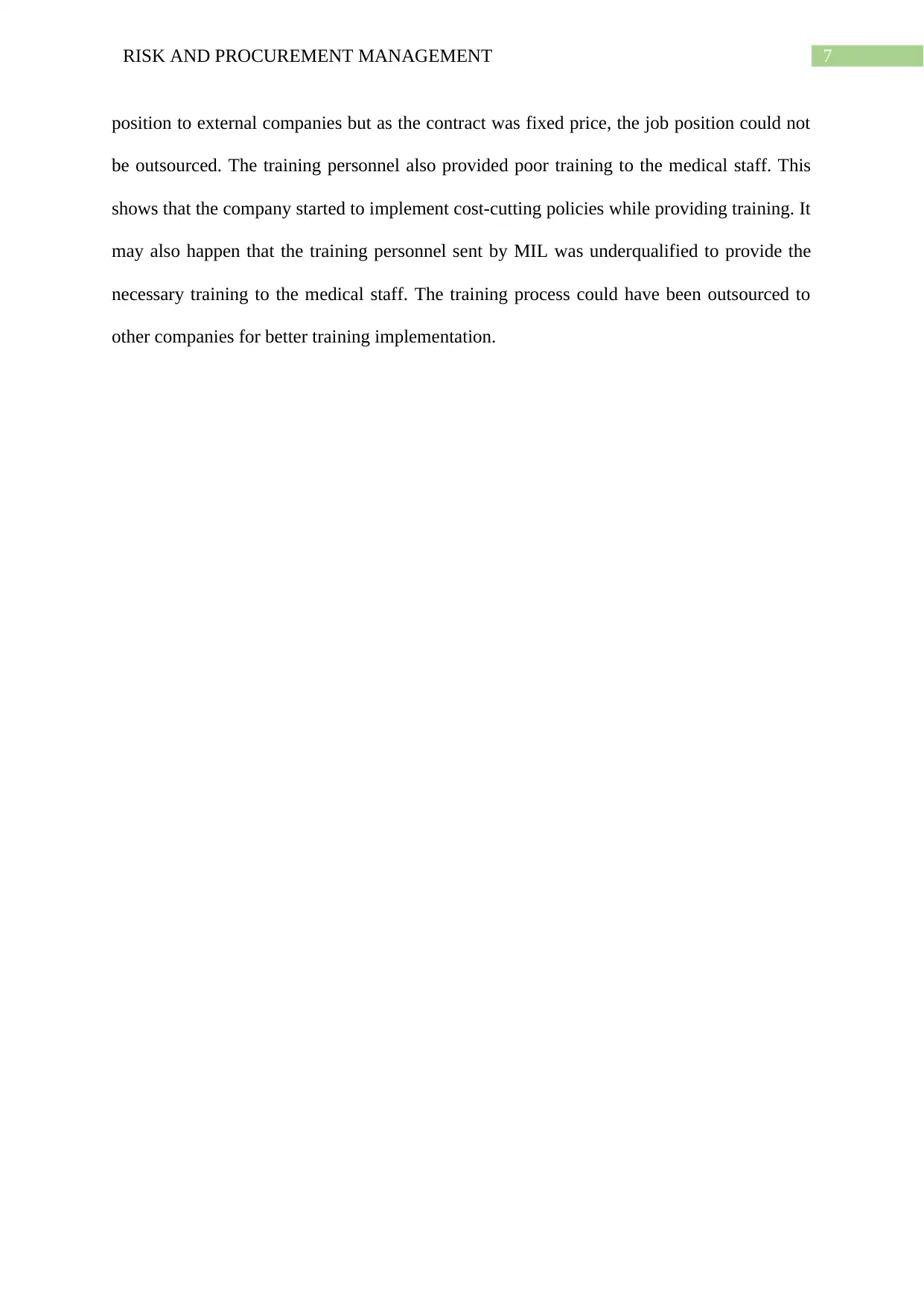
7RISK AND PROCUREMENT MANAGEMENT
position to external companies but as the contract was fixed price, the job position could not
be outsourced. The training personnel also provided poor training to the medical staff. This
shows that the company started to implement cost-cutting policies while providing training. It
may also happen that the training personnel sent by MIL was underqualified to provide the
necessary training to the medical staff. The training process could have been outsourced to
other companies for better training implementation.
position to external companies but as the contract was fixed price, the job position could not
be outsourced. The training personnel also provided poor training to the medical staff. This
shows that the company started to implement cost-cutting policies while providing training. It
may also happen that the training personnel sent by MIL was underqualified to provide the
necessary training to the medical staff. The training process could have been outsourced to
other companies for better training implementation.
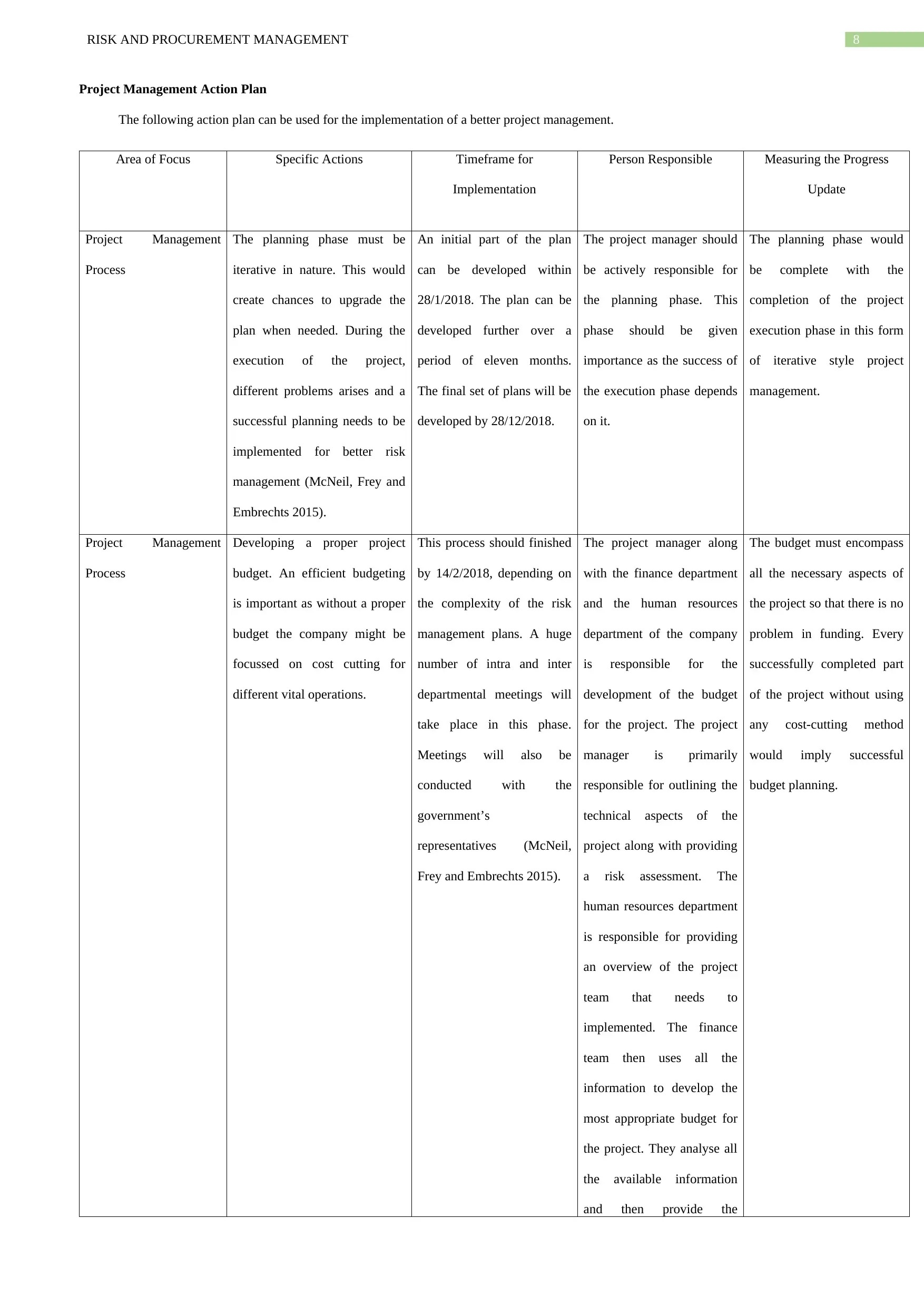
8RISK AND PROCUREMENT MANAGEMENT
Project Management Action Plan
The following action plan can be used for the implementation of a better project management.
Area of Focus Specific Actions Timeframe for
Implementation
Person Responsible Measuring the Progress
Update
Project Management
Process
The planning phase must be
iterative in nature. This would
create chances to upgrade the
plan when needed. During the
execution of the project,
different problems arises and a
successful planning needs to be
implemented for better risk
management (McNeil, Frey and
Embrechts 2015).
An initial part of the plan
can be developed within
28/1/2018. The plan can be
developed further over a
period of eleven months.
The final set of plans will be
developed by 28/12/2018.
The project manager should
be actively responsible for
the planning phase. This
phase should be given
importance as the success of
the execution phase depends
on it.
The planning phase would
be complete with the
completion of the project
execution phase in this form
of iterative style project
management.
Project Management
Process
Developing a proper project
budget. An efficient budgeting
is important as without a proper
budget the company might be
focussed on cost cutting for
different vital operations.
This process should finished
by 14/2/2018, depending on
the complexity of the risk
management plans. A huge
number of intra and inter
departmental meetings will
take place in this phase.
Meetings will also be
conducted with the
government’s
representatives (McNeil,
Frey and Embrechts 2015).
The project manager along
with the finance department
and the human resources
department of the company
is responsible for the
development of the budget
for the project. The project
manager is primarily
responsible for outlining the
technical aspects of the
project along with providing
a risk assessment. The
human resources department
is responsible for providing
an overview of the project
team that needs to
implemented. The finance
team then uses all the
information to develop the
most appropriate budget for
the project. They analyse all
the available information
and then provide the
The budget must encompass
all the necessary aspects of
the project so that there is no
problem in funding. Every
successfully completed part
of the project without using
any cost-cutting method
would imply successful
budget planning.
Project Management Action Plan
The following action plan can be used for the implementation of a better project management.
Area of Focus Specific Actions Timeframe for
Implementation
Person Responsible Measuring the Progress
Update
Project Management
Process
The planning phase must be
iterative in nature. This would
create chances to upgrade the
plan when needed. During the
execution of the project,
different problems arises and a
successful planning needs to be
implemented for better risk
management (McNeil, Frey and
Embrechts 2015).
An initial part of the plan
can be developed within
28/1/2018. The plan can be
developed further over a
period of eleven months.
The final set of plans will be
developed by 28/12/2018.
The project manager should
be actively responsible for
the planning phase. This
phase should be given
importance as the success of
the execution phase depends
on it.
The planning phase would
be complete with the
completion of the project
execution phase in this form
of iterative style project
management.
Project Management
Process
Developing a proper project
budget. An efficient budgeting
is important as without a proper
budget the company might be
focussed on cost cutting for
different vital operations.
This process should finished
by 14/2/2018, depending on
the complexity of the risk
management plans. A huge
number of intra and inter
departmental meetings will
take place in this phase.
Meetings will also be
conducted with the
government’s
representatives (McNeil,
Frey and Embrechts 2015).
The project manager along
with the finance department
and the human resources
department of the company
is responsible for the
development of the budget
for the project. The project
manager is primarily
responsible for outlining the
technical aspects of the
project along with providing
a risk assessment. The
human resources department
is responsible for providing
an overview of the project
team that needs to
implemented. The finance
team then uses all the
information to develop the
most appropriate budget for
the project. They analyse all
the available information
and then provide the
The budget must encompass
all the necessary aspects of
the project so that there is no
problem in funding. Every
successfully completed part
of the project without using
any cost-cutting method
would imply successful
budget planning.
⊘ This is a preview!⊘
Do you want full access?
Subscribe today to unlock all pages.

Trusted by 1+ million students worldwide
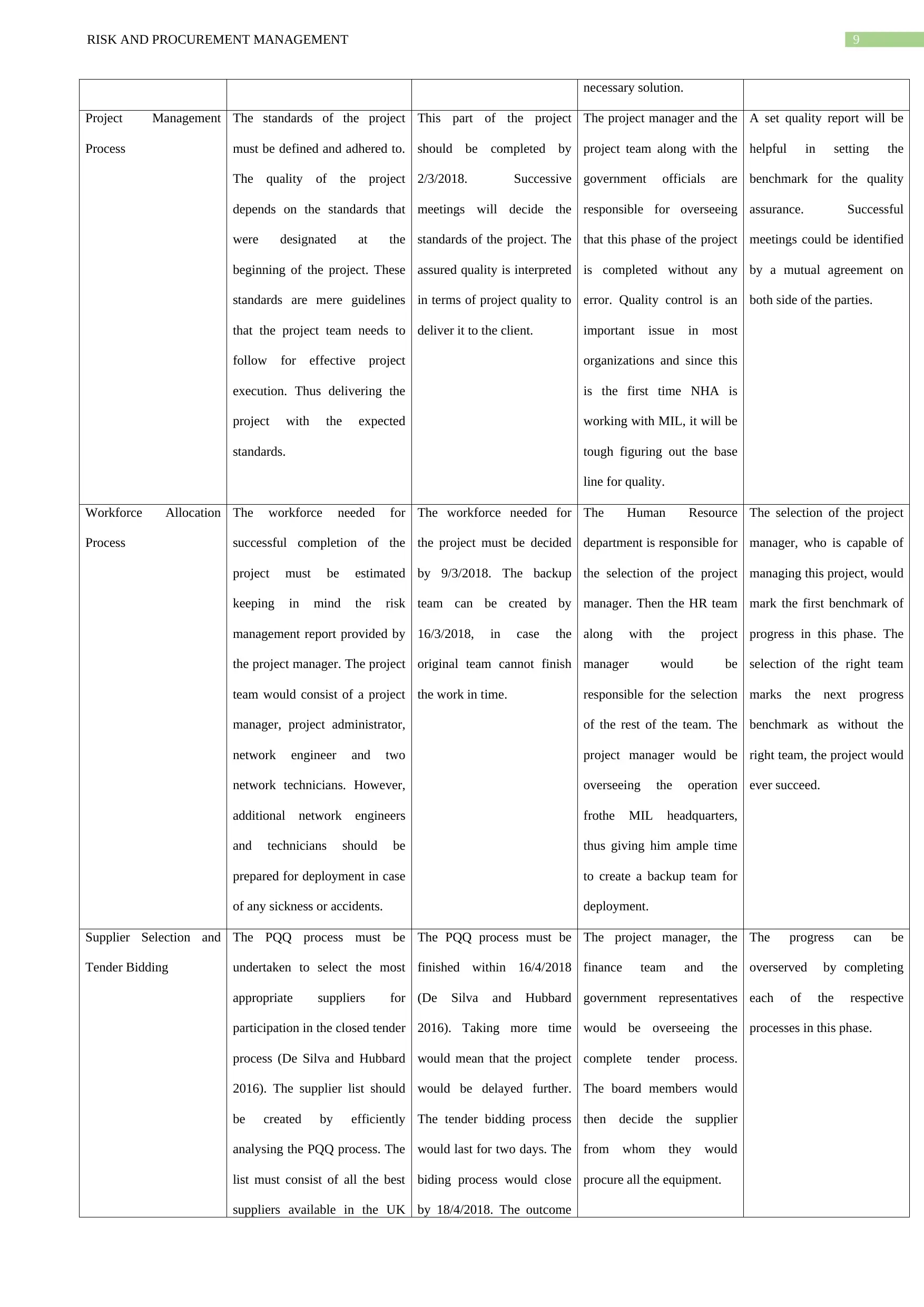
9RISK AND PROCUREMENT MANAGEMENT
necessary solution.
Project Management
Process
The standards of the project
must be defined and adhered to.
The quality of the project
depends on the standards that
were designated at the
beginning of the project. These
standards are mere guidelines
that the project team needs to
follow for effective project
execution. Thus delivering the
project with the expected
standards.
This part of the project
should be completed by
2/3/2018. Successive
meetings will decide the
standards of the project. The
assured quality is interpreted
in terms of project quality to
deliver it to the client.
The project manager and the
project team along with the
government officials are
responsible for overseeing
that this phase of the project
is completed without any
error. Quality control is an
important issue in most
organizations and since this
is the first time NHA is
working with MIL, it will be
tough figuring out the base
line for quality.
A set quality report will be
helpful in setting the
benchmark for the quality
assurance. Successful
meetings could be identified
by a mutual agreement on
both side of the parties.
Workforce Allocation
Process
The workforce needed for
successful completion of the
project must be estimated
keeping in mind the risk
management report provided by
the project manager. The project
team would consist of a project
manager, project administrator,
network engineer and two
network technicians. However,
additional network engineers
and technicians should be
prepared for deployment in case
of any sickness or accidents.
The workforce needed for
the project must be decided
by 9/3/2018. The backup
team can be created by
16/3/2018, in case the
original team cannot finish
the work in time.
The Human Resource
department is responsible for
the selection of the project
manager. Then the HR team
along with the project
manager would be
responsible for the selection
of the rest of the team. The
project manager would be
overseeing the operation
frothe MIL headquarters,
thus giving him ample time
to create a backup team for
deployment.
The selection of the project
manager, who is capable of
managing this project, would
mark the first benchmark of
progress in this phase. The
selection of the right team
marks the next progress
benchmark as without the
right team, the project would
ever succeed.
Supplier Selection and
Tender Bidding
The PQQ process must be
undertaken to select the most
appropriate suppliers for
participation in the closed tender
process (De Silva and Hubbard
2016). The supplier list should
be created by efficiently
analysing the PQQ process. The
list must consist of all the best
suppliers available in the UK
The PQQ process must be
finished within 16/4/2018
(De Silva and Hubbard
2016). Taking more time
would mean that the project
would be delayed further.
The tender bidding process
would last for two days. The
biding process would close
by 18/4/2018. The outcome
The project manager, the
finance team and the
government representatives
would be overseeing the
complete tender process.
The board members would
then decide the supplier
from whom they would
procure all the equipment.
The progress can be
overserved by completing
each of the respective
processes in this phase.
necessary solution.
Project Management
Process
The standards of the project
must be defined and adhered to.
The quality of the project
depends on the standards that
were designated at the
beginning of the project. These
standards are mere guidelines
that the project team needs to
follow for effective project
execution. Thus delivering the
project with the expected
standards.
This part of the project
should be completed by
2/3/2018. Successive
meetings will decide the
standards of the project. The
assured quality is interpreted
in terms of project quality to
deliver it to the client.
The project manager and the
project team along with the
government officials are
responsible for overseeing
that this phase of the project
is completed without any
error. Quality control is an
important issue in most
organizations and since this
is the first time NHA is
working with MIL, it will be
tough figuring out the base
line for quality.
A set quality report will be
helpful in setting the
benchmark for the quality
assurance. Successful
meetings could be identified
by a mutual agreement on
both side of the parties.
Workforce Allocation
Process
The workforce needed for
successful completion of the
project must be estimated
keeping in mind the risk
management report provided by
the project manager. The project
team would consist of a project
manager, project administrator,
network engineer and two
network technicians. However,
additional network engineers
and technicians should be
prepared for deployment in case
of any sickness or accidents.
The workforce needed for
the project must be decided
by 9/3/2018. The backup
team can be created by
16/3/2018, in case the
original team cannot finish
the work in time.
The Human Resource
department is responsible for
the selection of the project
manager. Then the HR team
along with the project
manager would be
responsible for the selection
of the rest of the team. The
project manager would be
overseeing the operation
frothe MIL headquarters,
thus giving him ample time
to create a backup team for
deployment.
The selection of the project
manager, who is capable of
managing this project, would
mark the first benchmark of
progress in this phase. The
selection of the right team
marks the next progress
benchmark as without the
right team, the project would
ever succeed.
Supplier Selection and
Tender Bidding
The PQQ process must be
undertaken to select the most
appropriate suppliers for
participation in the closed tender
process (De Silva and Hubbard
2016). The supplier list should
be created by efficiently
analysing the PQQ process. The
list must consist of all the best
suppliers available in the UK
The PQQ process must be
finished within 16/4/2018
(De Silva and Hubbard
2016). Taking more time
would mean that the project
would be delayed further.
The tender bidding process
would last for two days. The
biding process would close
by 18/4/2018. The outcome
The project manager, the
finance team and the
government representatives
would be overseeing the
complete tender process.
The board members would
then decide the supplier
from whom they would
procure all the equipment.
The progress can be
overserved by completing
each of the respective
processes in this phase.
Paraphrase This Document
Need a fresh take? Get an instant paraphrase of this document with our AI Paraphraser
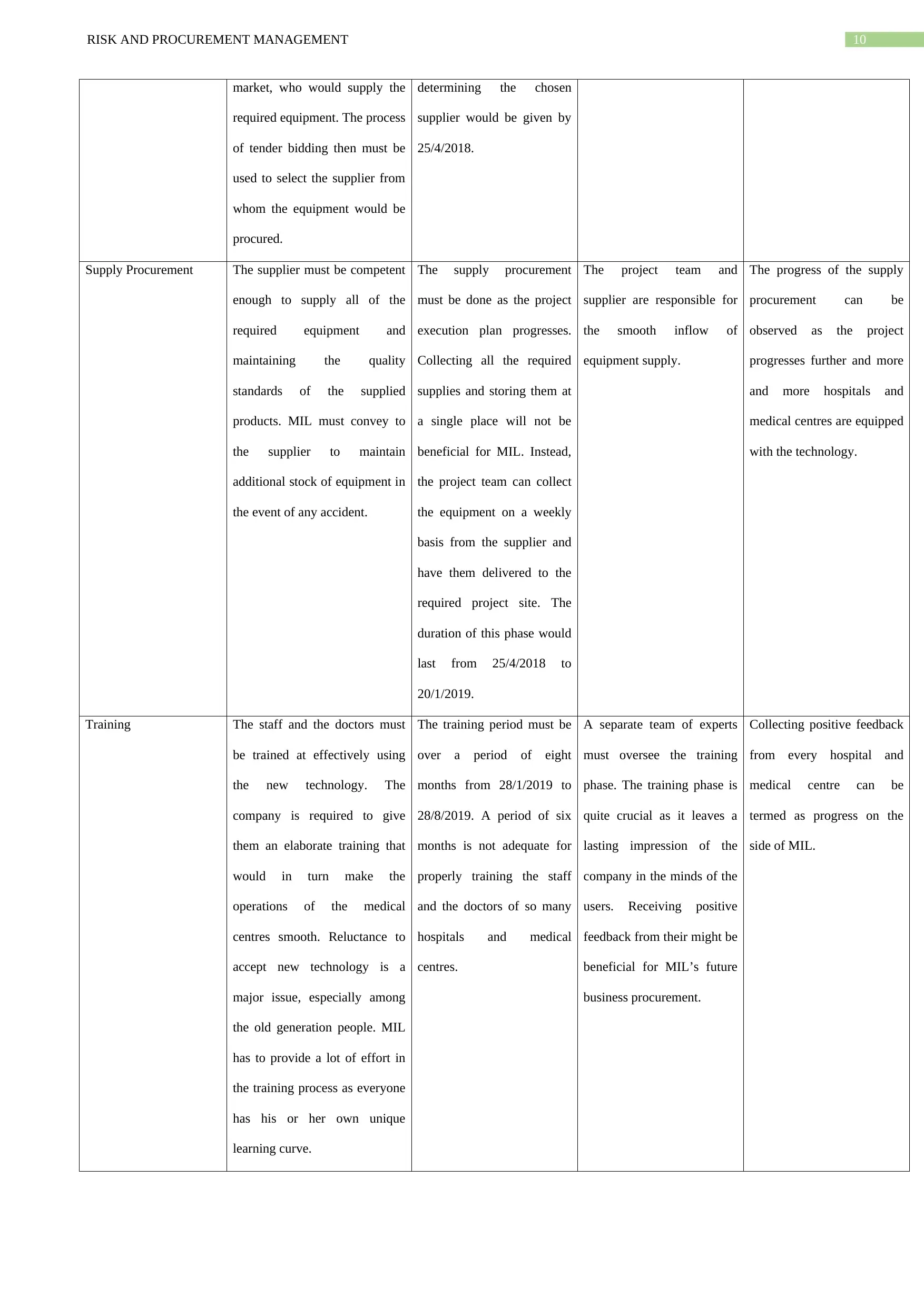
10RISK AND PROCUREMENT MANAGEMENT
market, who would supply the
required equipment. The process
of tender bidding then must be
used to select the supplier from
whom the equipment would be
procured.
determining the chosen
supplier would be given by
25/4/2018.
Supply Procurement The supplier must be competent
enough to supply all of the
required equipment and
maintaining the quality
standards of the supplied
products. MIL must convey to
the supplier to maintain
additional stock of equipment in
the event of any accident.
The supply procurement
must be done as the project
execution plan progresses.
Collecting all the required
supplies and storing them at
a single place will not be
beneficial for MIL. Instead,
the project team can collect
the equipment on a weekly
basis from the supplier and
have them delivered to the
required project site. The
duration of this phase would
last from 25/4/2018 to
20/1/2019.
The project team and
supplier are responsible for
the smooth inflow of
equipment supply.
The progress of the supply
procurement can be
observed as the project
progresses further and more
and more hospitals and
medical centres are equipped
with the technology.
Training The staff and the doctors must
be trained at effectively using
the new technology. The
company is required to give
them an elaborate training that
would in turn make the
operations of the medical
centres smooth. Reluctance to
accept new technology is a
major issue, especially among
the old generation people. MIL
has to provide a lot of effort in
the training process as everyone
has his or her own unique
learning curve.
The training period must be
over a period of eight
months from 28/1/2019 to
28/8/2019. A period of six
months is not adequate for
properly training the staff
and the doctors of so many
hospitals and medical
centres.
A separate team of experts
must oversee the training
phase. The training phase is
quite crucial as it leaves a
lasting impression of the
company in the minds of the
users. Receiving positive
feedback from their might be
beneficial for MIL’s future
business procurement.
Collecting positive feedback
from every hospital and
medical centre can be
termed as progress on the
side of MIL.
market, who would supply the
required equipment. The process
of tender bidding then must be
used to select the supplier from
whom the equipment would be
procured.
determining the chosen
supplier would be given by
25/4/2018.
Supply Procurement The supplier must be competent
enough to supply all of the
required equipment and
maintaining the quality
standards of the supplied
products. MIL must convey to
the supplier to maintain
additional stock of equipment in
the event of any accident.
The supply procurement
must be done as the project
execution plan progresses.
Collecting all the required
supplies and storing them at
a single place will not be
beneficial for MIL. Instead,
the project team can collect
the equipment on a weekly
basis from the supplier and
have them delivered to the
required project site. The
duration of this phase would
last from 25/4/2018 to
20/1/2019.
The project team and
supplier are responsible for
the smooth inflow of
equipment supply.
The progress of the supply
procurement can be
observed as the project
progresses further and more
and more hospitals and
medical centres are equipped
with the technology.
Training The staff and the doctors must
be trained at effectively using
the new technology. The
company is required to give
them an elaborate training that
would in turn make the
operations of the medical
centres smooth. Reluctance to
accept new technology is a
major issue, especially among
the old generation people. MIL
has to provide a lot of effort in
the training process as everyone
has his or her own unique
learning curve.
The training period must be
over a period of eight
months from 28/1/2019 to
28/8/2019. A period of six
months is not adequate for
properly training the staff
and the doctors of so many
hospitals and medical
centres.
A separate team of experts
must oversee the training
phase. The training phase is
quite crucial as it leaves a
lasting impression of the
company in the minds of the
users. Receiving positive
feedback from their might be
beneficial for MIL’s future
business procurement.
Collecting positive feedback
from every hospital and
medical centre can be
termed as progress on the
side of MIL.
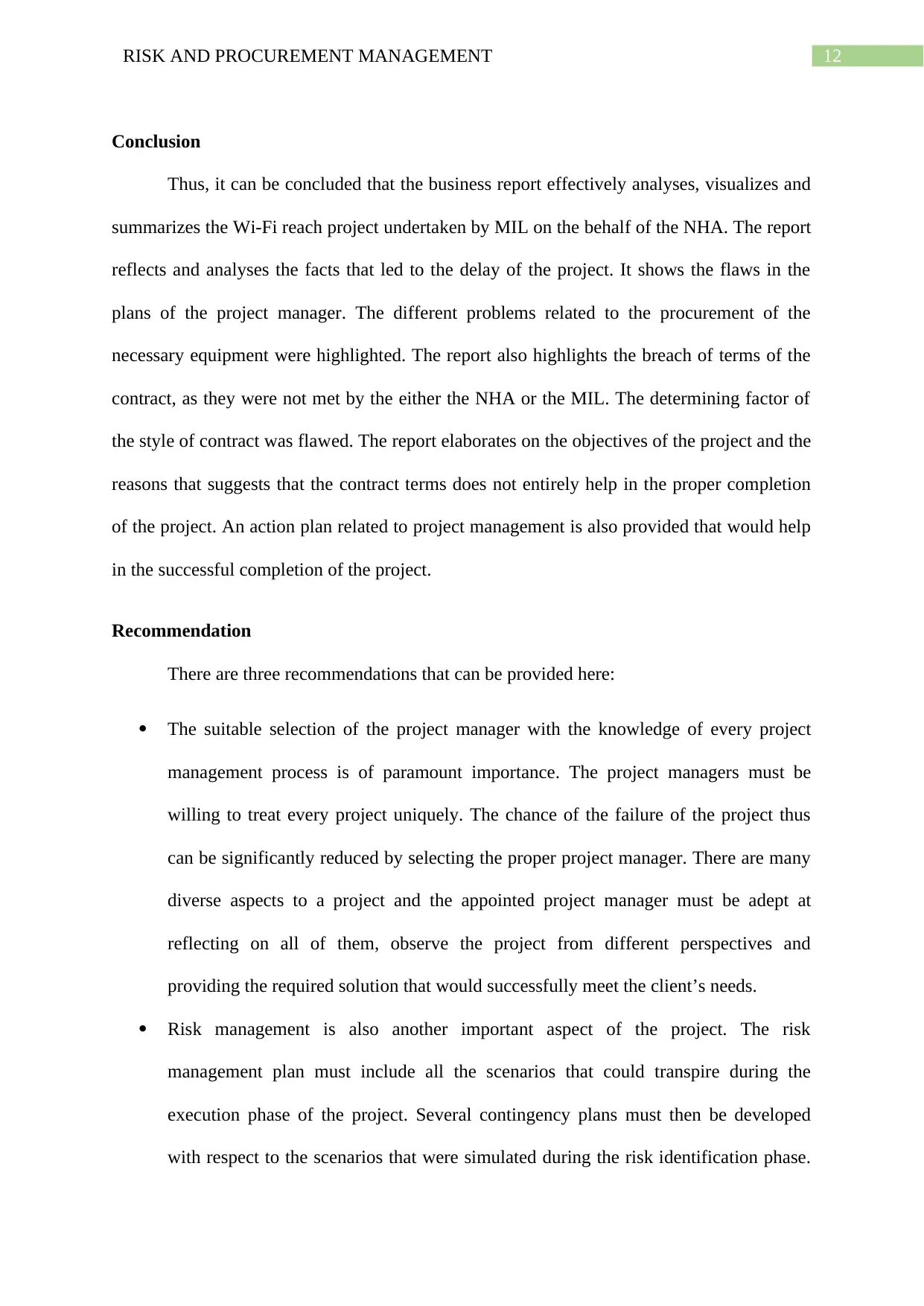
12RISK AND PROCUREMENT MANAGEMENT
Conclusion
Thus, it can be concluded that the business report effectively analyses, visualizes and
summarizes the Wi-Fi reach project undertaken by MIL on the behalf of the NHA. The report
reflects and analyses the facts that led to the delay of the project. It shows the flaws in the
plans of the project manager. The different problems related to the procurement of the
necessary equipment were highlighted. The report also highlights the breach of terms of the
contract, as they were not met by the either the NHA or the MIL. The determining factor of
the style of contract was flawed. The report elaborates on the objectives of the project and the
reasons that suggests that the contract terms does not entirely help in the proper completion
of the project. An action plan related to project management is also provided that would help
in the successful completion of the project.
Recommendation
There are three recommendations that can be provided here:
The suitable selection of the project manager with the knowledge of every project
management process is of paramount importance. The project managers must be
willing to treat every project uniquely. The chance of the failure of the project thus
can be significantly reduced by selecting the proper project manager. There are many
diverse aspects to a project and the appointed project manager must be adept at
reflecting on all of them, observe the project from different perspectives and
providing the required solution that would successfully meet the client’s needs.
Risk management is also another important aspect of the project. The risk
management plan must include all the scenarios that could transpire during the
execution phase of the project. Several contingency plans must then be developed
with respect to the scenarios that were simulated during the risk identification phase.
Conclusion
Thus, it can be concluded that the business report effectively analyses, visualizes and
summarizes the Wi-Fi reach project undertaken by MIL on the behalf of the NHA. The report
reflects and analyses the facts that led to the delay of the project. It shows the flaws in the
plans of the project manager. The different problems related to the procurement of the
necessary equipment were highlighted. The report also highlights the breach of terms of the
contract, as they were not met by the either the NHA or the MIL. The determining factor of
the style of contract was flawed. The report elaborates on the objectives of the project and the
reasons that suggests that the contract terms does not entirely help in the proper completion
of the project. An action plan related to project management is also provided that would help
in the successful completion of the project.
Recommendation
There are three recommendations that can be provided here:
The suitable selection of the project manager with the knowledge of every project
management process is of paramount importance. The project managers must be
willing to treat every project uniquely. The chance of the failure of the project thus
can be significantly reduced by selecting the proper project manager. There are many
diverse aspects to a project and the appointed project manager must be adept at
reflecting on all of them, observe the project from different perspectives and
providing the required solution that would successfully meet the client’s needs.
Risk management is also another important aspect of the project. The risk
management plan must include all the scenarios that could transpire during the
execution phase of the project. Several contingency plans must then be developed
with respect to the scenarios that were simulated during the risk identification phase.
⊘ This is a preview!⊘
Do you want full access?
Subscribe today to unlock all pages.

Trusted by 1+ million students worldwide
1 out of 13
Related Documents
Your All-in-One AI-Powered Toolkit for Academic Success.
+13062052269
info@desklib.com
Available 24*7 on WhatsApp / Email
![[object Object]](/_next/static/media/star-bottom.7253800d.svg)
Unlock your academic potential
Copyright © 2020–2025 A2Z Services. All Rights Reserved. Developed and managed by ZUCOL.





